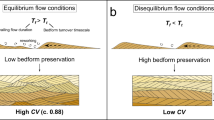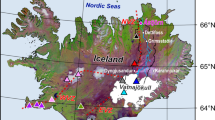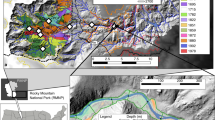Abstract
Measured rates of river incision into bedrock are commonly interpreted as proxies for rates of rock uplift (see refs 1 and 2, for example) and indices of the strength of climatic forcing of erosion over time (see refs 3 and 4, for example). This approach implicitly assumes that river incision rates are in equilibrium with external forcings over a wide range of timescales. Here we directly test this assumption by examining the temporal scaling of bedrock river incision from 155 independent measurements of river incision compiled from 14 sites. Of these sites, 11 exhibit a negative power-law dependence of bedrock river incision rate on measurement interval, a relationship that is apparent over timescales of 104–107 years and is independent of tectonic and geomorphic setting. Thus, like rates of sediment accumulation5, rates of river incision into bedrock exhibit non-steady-state behaviour even over very long measurement intervals. Non-steady-state behaviour can be explained by episodic hiatuses in river incision triggered by alluvial deposition, if such hiatuses have a heavy-tailed length distribution6. Regardless of its cause, the dependence of incision rate on measurement interval complicates efforts to infer tectonic or climatic forcing from changes in rates of river incision over time or from comparison of rates computed over different timescales.
This is a preview of subscription content, access via your institution
Access options
Subscribe to this journal
Receive 51 print issues and online access
$199.00 per year
only $3.90 per issue
Buy this article
- Purchase on Springer Link
- Instant access to full article PDF
Prices may be subject to local taxes which are calculated during checkout



Similar content being viewed by others
References
Pazzaglia, F. J. & Brandon, M. T. A fluvial record of long-term steady-state uplift and erosion across the Cascadia forearc high, western Washington State. Am. J. Sci. 301, 385–431 (2001)
Burbank, D. W. et al. Bedrock incision, rock uplift and threshold hillslopes in the northwestern Himalayas. Nature 379, 505–510 (1996)
Leland, J., Reid, M. R., Burbank, D. W., Finkel, R. & Caffee, M. Incision and differential bedrock uplift along the Indus River near Nanga Parbat, Pakistan Himalaya, from 10Be and 26Al exposure age dating of bedrock straths. Earth Planet. Sci. Lett. 154, 93–107 (1998)
Bull, W. L. & Knuepfer, P. L. K. Adjustments by the Charwell River, New Zealand, to uplift and climatic changes. Geomorphology 1, 15–32 (1987)
Jerolmack, D. J. & Sadler, P. Transience and persistence in the depositional record of continental margins. J. Geophys. Res. 112, F03S13 (2007)
Schumer, R. & Jerolmack, D. J. Real and apparent changes in sediment deposition rates through time. J. Geophys. Res. 114, F00A06 (2009)
Howard, A. D., Dietrich, W. E. & Seidl, M. A. Modeling fluvial erosion on regional to continental scales. J. Geophys. Res. 99, 13971–13986 (1994)
Whipple, K. X. Bedrock rivers and the geomorphology of active orogens. Annu. Rev. Earth Planet. Sci. 32, 151–185 (2004)
Molnar, P. et al. Quaternary climate change and the formation of river terraces across growing anticlines on the north flank of the Tien Shan, China. J. Geol. 102, 583–602 (1994)
Hancock, G. S. & Anderson, R. S. Numerical modeling of fluvial strath-terrace formation in response to oscillating climate. Geol. Soc. Am. Bull. 114, 1131–1142 (2002)
Sadler, P. M. Sediment accumulation rates and the completeness of stratigraphic sections. J. Geol. 89, 569–584 (1981)
Lague, D. Reduction of long-term bedrock incision efficiency by short-term alluvial cover intermittency. J. Geophys. Res. 115, F02011 (2010)
Redner, S. A Guide to First-Passage Processes Chs 1 and 3 (Cambridge Univ. Press, 2007)
Ding, M. Z. & Yang, W. M. Distribution of the first return time in fractional Brownian-motion and its application to the study of on-off intermittency. Phys. Rev. E 52, 207–213 (1995)
Yanites, B. J., Tucker, G. E., Mueller, K. J. & Chen, Y.-G. How rivers react to large earthquakes: evidence from central Taiwan. Geology 38, 639–642 (2010)
Roering, J. J. & Gerber, M. Fire and the evolution of steep, soil-mantled landscapes. Geology 33, 349–352 (2005)
Benda, L. The influence of debris flows on channels and valley floors in the Oregon Coast Range, U.S.A. Earth Surf. Process. Landf. 15, 457–466 (1990)
Jerolmack, D. J. & Paola, C. Shredding of environmental signals by sediment transport. Geophys. Res. Lett. 37, L19401 (2010)
Mills, H. H. Apparent increasing rates of stream incision in the eastern United States during the late Cenozoic. Geology 28, 955–957 (2000)
Gardner, T. W., Jorgensen, D. W., Shuman, C. & Lemieux, C. R. Geomorphic and tectonic process rates: effects of measured time interval. Geology 15, 259–261 (1987)
Whittaker, A. C., Cowie, P. A., Attal, M., Tucker, G. E. & Roberts, G. P. Bedrock channel adjustment to tectonic forcing: implications for predicting river incision rates. Geology 35, 103–106 (2007)
Lamb, M. P. & Fonstad, M. A. Rapid formation of a modern bedrock canyon by a single flood event. Nature Geosci. 3, 477–481 (2010)
Schaller, M. et al. Fluvial bedrock incision in the active mountain belt of Taiwan from in situ-produced cosmogenic nuclides. Earth Surf. Process. Landf. 30, 955–971 (2005)
Blöthe, J. H. & Korup, O. Millennial lag times in the Himalayan sediment routing system. Earth Planet. Sci. Lett. 382, 38–46 (2013)
Kirchner, J. W. et al. Mountain erosion over 10 yr, 10 k.y., and 10 m.y. time scales. Geology 29, 591–594 (2001)
Turowski, J. M., Hovius, N., Wilson, A. & Horng, M.-J. Hydraulic geometry, river sediment and the definition of bedrock channels. Geomorphology 99, 26–38 (2008)
Ouimet, W. B., Whipple, K. X., Royden, L. H., Sun, Z. & Chen, Z. The influence of large landslides on river incision in a transient landscape: eastern margin of the Tibetan Plateau (Sichuan, China). Geol. Soc. Am. Bull. 119, 1462–1476 (2007)
Gani, N. D. S., Gani, M. R. & Abdelsalam, M. G. Blue Nile incision on the Ethiopian Plateau: pulsed plateau growth, Pliocene uplift, and hominin evolution. GSA Today 17 (9). 4–11 (2007)
Sadler, P. & Jerolmack, D. J. Scaling laws for aggradation, denudation and progradation rates: the case for time-scale invariance at sediment sources and sinks. In Strata and Time: Probing the Gaps in Our Understanding (eds Smith, D. & Burgess, P. ) (Geological Society of London Special Publication, in the press).
Wegmann, K. W. & Pazzaglia, F. J. Holocene strath terraces, climate change, and active tectonics: the Clearwater River basin, Olympic Peninsula, Washington State. Geol. Soc. Am. Bull. 114, 731–744 (2002)
Personius, S. F. Late Quaternary stream incision and uplift in the forearc of the Cascadia subduction zone, western Oregon. J. Geophys. Res. 100, 20193–120210 (1995)
Wegmann, K. W. & Pazzaglia, F. J. Late Quaternary fluvial terraces of the Romagna and Marche Apennines, Italy: climatic, lithologic, and tectonic controls on terrace genesis in an active orogen. Quat. Sci. Rev. 28, 137–165 (2009)
Li, J.-J. et al. Magnetostratigraphic dating of river terraces: rapid and intermittent incision by the Yellow River of the northeastern margin of the Tibetan Plateau during the Quaternary. J. Geophys. Res. 102, 10121–10132 (1997)
Stock, G. M., Anderson, R. S. & Finkel, R. C. Rates of erosion and topographic evolution of the Sierra Nevada, California, inferred from cosmogenic 26Al and 10Be concentrations. Earth Surf. Process. Landf. 30, 985–1006 (2005)
Cook, K. L., Whipple, K. X., Heimsath, A. M. & Hanks, T. C. Rapid incision of the Colorado River in Glen Canyon — insights from channel profiles, local incision rates, and modeling of lithologic controls. Earth Surf. Process. Landf. 34, 994–1010 (2009)
Karlstrom, K. E. et al. 40Ar/39Ar and field studies of Quaternary basalts in Grand Canyon and model for carving Grand Canyon: quantifying the interaction of river incision and normal faulting across the western edge of the Colorado Plateau. Geol. Soc. Am. Bull. 119, 1283–1312 (2007)
Cheng, S., Deng, Q., Zhou, S. & Yang, G. Strath terraces of Jinshaan Canyon, Yellow River, and Quaternary tectonic movements of the Ordos Plateau, North China. Terra Nova 14, 215–224 (2002)
Granger, D. E., Fabel, D. & Palmer, A. N. Pliocene−Pleistocene incision of the Green River, Kentucky, determined from radioactive decay of cosmogenic 26Al and 10Be in Mammoth Cave sediments. Geol. Soc. Am. Bull. 113, 825–836 (2001)
Anthony, D. M. & Granger, D. E. A late Tertiary origin for multilevel caves along the western escarpment of the Cumberland Plateau, Tennessee and Kentucky, established by cosmogenic 26Al and 10Be. J. Caves Karst Stud. 66, 46–55 (2004)
Acknowledgements
This study was supported in part by the National Science Foundation (EAR-1049889). We thank J. Kirchner, B. Crosby and K. Ferrier for discussion and comments that improved the manuscript.
Author information
Authors and Affiliations
Contributions
N.J.F. and S.F. compiled the datasets and performed the statistical analyses, R.S. provided guidance on the theory of stochastic processes, and N.J.F. wrote the paper with input from the other authors.
Corresponding author
Ethics declarations
Competing interests
The authors declare no competing financial interests.
Extended data figures and tables
Supplementary information
Supplementary Data
This file contains Supplementary Table 1. (PDF 64 kb)
Rights and permissions
About this article
Cite this article
Finnegan, N., Schumer, R. & Finnegan, S. A signature of transience in bedrock river incision rates over timescales of 104–107 years. Nature 505, 391–394 (2014). https://doi.org/10.1038/nature12913
Received:
Accepted:
Published:
Issue Date:
DOI: https://doi.org/10.1038/nature12913
This article is cited by
-
Fault systems impede incision of the Yarlung river into the Tibetan plateau
Communications Earth & Environment (2023)
-
Driving effects of dynamic geomorphologic environments on gravitational erosion hazards: a case of the Baihetan drainage area of the Jinsha River, China
Bulletin of Engineering Geology and the Environment (2023)
-
The shaping of erosional landscapes by internal dynamics
Nature Reviews Earth & Environment (2020)
-
Late Cenozoic climate change paces landscape adjustments to Yukon River capture
Nature Geoscience (2020)
-
Long-term dispersion of river gravel in a canyon in the Atacama Desert, Central Andes, deduced from their 10Be concentrations
Scientific Reports (2019)
Comments
By submitting a comment you agree to abide by our Terms and Community Guidelines. If you find something abusive or that does not comply with our terms or guidelines please flag it as inappropriate.



